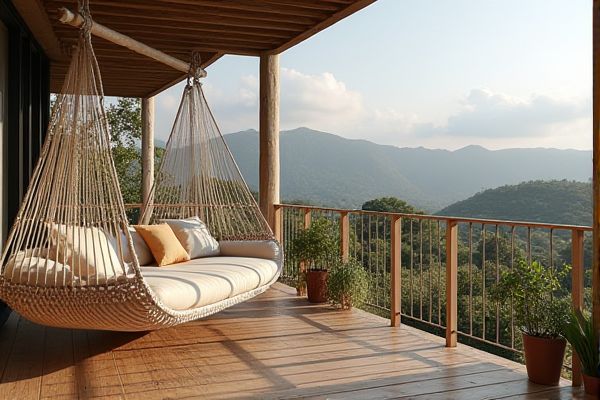
String hammocks offer excellent breathability and a lightweight design ideal for warm terrace settings, while fabric hammocks provide greater comfort with a sturdier, cushioned surface that resists stretching and sagging over time. Discover which option best suits your terrace needs and preferences by reading the rest of this article.
Table of Comparison
| Feature | String Hammock | Fabric Hammock (Terrace) |
|---|---|---|
| Material | Woven cotton or polyester strings | Solid cotton, polyester, or canvas fabric |
| Comfort | Breathable, conforms to body | Soft, supportive, less ventilation |
| Durability | Moderate; prone to wear on strings | High; resistant to tears and stains |
| Weight Capacity | Typically up to 200-300 lbs | Typically up to 300-400 lbs |
| Maintenance | Easy to clean, may require gentle washing | Machine washable, fade-resistant |
| Suitability for Terrace | Good for airy setups, limited shade | Ideal for shaded or covered terraces |
| Price Range | Affordable; $30-$80 | Moderate to expensive; $70-$150 |
| Appearance | Classic, open-weave look | Solid colors or patterns, modern look |
String Hammock vs Fabric Hammock: Key Differences
String hammocks offer superior breathability and lightweight comfort, making them ideal for warm terrace climates where airflow is essential. Fabric hammocks provide enhanced durability and support with a solid weave that resists wear and offers greater protection against sun damage. Your choice depends on whether you prioritize ventilation and lightness or strength and longevity for terrace relaxation.
Material Composition and Durability
String hammocks typically consist of cotton or polyester ropes woven into an open mesh pattern, offering breathability but less resistance to weather elements. Fabric hammocks, made from tightly woven materials like canvas or weather-resistant polyester, provide increased durability and better protection against fading and wear. Choosing fabric hammocks enhances longevity on terraces exposed to sun and moisture, while string hammocks require more maintenance to sustain their structural integrity.
Comfort Level on the Terrace
Fabric hammocks offer superior comfort on terraces due to their soft, breathable material that conforms to the body, reducing pressure points during extended relaxation. String hammocks provide better ventilation but may cause uneven support and leave imprints on the skin, making them less ideal for long-term lounging. For optimal terrace comfort, fabric hammocks with cushioned or padded options enhance relaxation and prevent discomfort.
Weather Resistance and Maintenance
Fabric hammocks on terraces often feature weather-resistant, UV-protected materials that prevent fading and mildew, making them easier to maintain during changing weather conditions. String hammocks, usually crafted from cotton or polyester, offer breathability but require more frequent cleaning and protection from moisture to avoid mildew and wear. Choosing weather-resistant polyester string hammocks balances durability with low maintenance, while acrylic or olefin fabric options provide superior resistance to sun and rain damage.
Aesthetics and Terrace Décor
String hammocks offer a lightweight, airy appearance that complements a modern or bohemian terrace decor with their intricate patterns and open weave, allowing natural light to filter through. Fabric hammocks provide a solid, colorful surface that can anchor the terrace design and add a cozy, inviting vibe, often enhancing comfort while serving as a bold statement piece. Choosing between the two depends on whether you want your terrace to evoke a relaxed, breezy ambiance or a warm, plush aesthetic that invites you to unwind.
Weight Capacity and Support
String hammocks typically offer lower weight capacity and less uniform support compared to fabric hammocks, as the open weave can create pressure points that strain comfort. Fabric hammocks, often crafted from thick cotton or polyester canvas, provide higher weight capacity--commonly up to 450 pounds or more--and distribute body weight evenly for superior support. For terrace use, fabric hammocks ensure enhanced durability and stability, making them ideal for extended relaxation sessions.
Installation and Storage Flexibility
String hammocks offer easy installation with lightweight materials and simple hooks, making them ideal for quick setup and removal on terraces. Fabric hammocks tend to be bulkier but provide more durability and comfort, requiring sturdier support structures that may limit flexibility in placement. Your choice depends on whether you prioritize easy storage and installation or a more robust, comfortable lounging experience.
Price Comparison: String vs Fabric
String hammocks typically cost less than fabric hammocks due to their simpler design and lighter materials, making them a budget-friendly choice for your terrace. Fabric hammocks, made from durable materials like cotton or polyester, often come at a higher price but offer greater comfort and longevity. Investing in a fabric hammock may provide better value over time despite the higher initial cost.
Best Uses for Each Hammock Type
String hammocks offer superior airflow, making them ideal for hot terrace environments where breathability is crucial, while fabric hammocks provide enhanced comfort and support, suitable for extended relaxation sessions. String hammocks are perfect for quick naps and casual lounging, especially in sunny or breezy terraces, whereas fabric hammocks excel for reading or resting with extra cushioning. Choosing between them depends on climate, duration of use, and personal comfort preferences on your terrace.
Choosing the Right Hammock for Your Terrace
String hammocks offer breathable comfort and lightweight portability, making them ideal for warm terrace settings where airflow is essential. Fabric hammocks provide greater durability and protection from elements, suited for terraces exposed to sun or light rain. Selecting the right hammock depends on terrace conditions, desired comfort level, and maintenance preferences to ensure longevity and relaxation.
 homyna.com
homyna.com